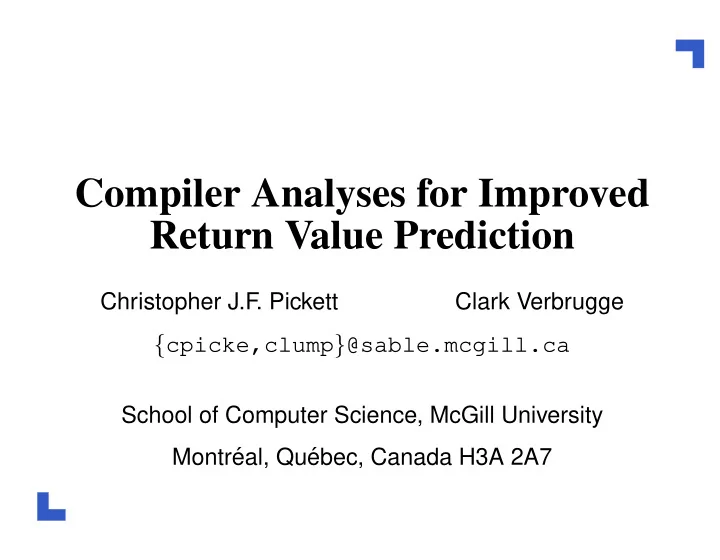

Compiler Analyses for Improved Return Value Prediction Christopher J.F . Pickett Clark Verbrugge { cpicke,clump } @sable.mcgill.ca School of Computer Science, McGill University Montr´ eal, Qu´ ebec, Canada H3A 2A7
Overview Introduction and Related Work Contributions Framework Parameter Dependence Analysis Return Value Use Analysis Conclusions Future Work CDP04 – 1/48
Introduction and Related Work Speculative method-level parallelism (SMLP) allows for dynamic parallelisation of single-threaded programs speculative threads are forked at callsites suitable for Java virtual machines Perfect return value prediction can double performance of SMLP (Hu et al. , 2003) Implemented accurate return value prediction in SableVM, our group’s JVM (Pickett et al. , 2004) Current goals: Reduce memory requirements Achieve higher accuracy CDP04 – 2/48
Speculative Method-Level Parallelism // execute foo non-speculatively r = foo (a, b, c); // execute past return point // speculatively in parallel with foo() if (r > 10) { ... } else { ... } CDP04 – 3/48
Impact of Return Value Prediction RVP strategy return value SMLP speedup none arbitrary 1.52 best predicted 1.92 perfect correct 2.76 26% speedup over no RVP with Hu’s best predictor 82% speedup over no RVP with perfect prediction Improved hybrid accuracy is highly desirable S. Hu., R. Bhargava, and L. K. John. The role of return value prediction in exploiting speculative method-level parallelism. Journal of Instruction-Level Parallelism , 5:1–21, Nov. 2003. CDP04 – 4/48
Return Value Prediction in SableVM Implemented all of Hu et al. ’s predictors in SableVM Introduced new memoization predictor into hybrid C.J.F. Pickett and C. Verbrugge. Return value prediction in a Java virtual machine. Second Value-Prediction and Value-Based Optimization Workshop (VPW2) at ASPLOS , Boston, Massachusetts, Oct. 2004. CDP04 – 5/48
Return Value Prediction in SableVM Achieved 72% accuracy over SPEC JVM98 81% if memoization is included But ... Large amounts of memory are required Still room for greater accuracy C.J.F. Pickett and C. Verbrugge. Return value prediction in a Java virtual machine. Second Value-Prediction and Value-Based Optimization Workshop (VPW2) at ASPLOS , Boston, Massachusetts, Oct. 2004. CDP04 – 6/48
Contributions Static analyses in Soot Parameter dependence analysis Eliminate unnecessary memoization inputs Save memory Increase accuracy Return value use analysis Allow for use of incorrect predictions Increase accuracy Convey results to SableVM using attributes CDP04 – 7/48
Framework Soot: Java bytecode compiler framework Spark: points-to analysis and callgraph Jimple: typed, stackless, 3-address IR Baf: streamlined representation of Java bytecode Attribute generation framework SableVM: portable Java virtual machine Attribute parsing Previous RVP implementation SPEC Client JVM98 Benchmark Suite S100 (size 100), no harness All benchmarks except raytrace CDP04 – 8/48
Parameter Dependence Analysis Memoization predictor Hash together method arguments One predictor hashtable per callsite Problem: redundant entries in hashtables CDP04 – 9/48
Parameter Dependence Analysis Insight: not all parameters affect return value Eliminate inputs to predictor Increase hashtable sharing ++accuracy -- size CDP04 – 10/48
Intraprocedural Parameter Dependence CDP04 – 11/48
Intraprocedural Parameter Dependence CDP04 – 12/48
Intraprocedural Parameter Dependence CDP04 – 13/48
Intraprocedural Parameter Dependence CDP04 – 14/48
Intraprocedural Parameter Dependence CDP04 – 15/48
Intraprocedural Parameter Dependence CDP04 – 16/48
Intraprocedural Parameter Dependence CDP04 – 17/48
Intraprocedural Parameter Dependence CDP04 – 18/48
Intraprocedural Parameter Dependence CDP04 – 19/48
Intraprocedural Parameter Dependence CDP04 – 20/48
Intraprocedural Parameter Dependence CDP04 – 21/48
Intraprocedural Parameter Dependence CDP04 – 22/48
Intraprocedural Parameter Dependence CDP04 – 23/48
Intraprocedural Parameter Dependence CDP04 – 24/48
Intraprocedural Parameter Dependence CDP04 – 25/48
Interprocedural Parameter Dependence CDP04 – 26/48
Interprocedural Parameter Dependence CDP04 – 27/48
Interprocedural Parameter Dependence CDP04 – 28/48
Interprocedural Parameter Dependence CDP04 – 29/48
Interprocedural Parameter Dependence CDP04 – 30/48
Interprocedural Parameter Dependence CDP04 – 31/48
Interprocedural Parameter Dependence CDP04 – 32/48
Interprocedural Parameter Dependence CDP04 – 33/48
Interprocedural Parameter Dependence CDP04 – 34/48
Interprocedural Parameter Dependence CDP04 – 35/48
Interprocedural Parameter Dependence CDP04 – 36/48
Parameter Dependence Results consumed non-void dependence type callsites methods full 51% 58% partial 22% 9% zero, with parameters 24% 30% zero, without parameters 3% 3% Memoization at 22% of callsites will be improved 27% of callsites do not benefit from memoization Average taken over SPEC JVM98 CDP04 – 37/48
Return Value Use Analysis An incorrect return value r may be OK If r is unused If r appears inside a boolean expression r = foo (a, b, c); if (r > 10) { ... // r == 11, 12, 13, ... } else { ... // r == 10, 9, 8, ... } CDP04 – 38/48
Return Value Use Analysis Collect use expressions for each return value Evaluate use expressions at runtime If predicted and actual return values satisfy use expressions identically, we can substitute an inaccurate prediction ++accuracy CDP04 – 39/48
Return Value Use CDP04 – 40/48
Return Value Use CDP04 – 41/48
Return Value Use CDP04 – 42/48
Return Value Use CDP04 – 43/48
Return Value Use CDP04 – 44/48
Return Value Use Results consumed accurate callsites (%) no no 21 yes no 10 yes yes 69 Use expressions only involve r and a constant Future: allow for locals as well as constants Relax accuracy constraints further CDP04 – 45/48
Conclusions (1) Two new compiler analyses for improved RVP Parameter dependence analysis: production Return value use analysis: consumption Static results look promising: 22% of callsites have partial dependencies 27% of callsites have zero dependencies 21% of return values are unconsumed 31% of return values may be inaccurate CDP04 – 46/48
Conclusions (2) Parameter dependence analysis is optimistic Conservative correctness not required Return value use analysis relaxes safety constraints CDP04 – 47/48
Future Work Allow for comparisons with locals in use expressions. At runtime, these values may be: Parameter locals Non-parameter locals Stack values Determine effect of analyses at runtime Implement purity analysis in Soot (S˘ alcianu, Rinard) Skip pure methods altogether via memoization! Finish SMLP implementation in SableVM Study costs and benefits of RVP in this system CDP04 – 48/48
Recommend
More recommend